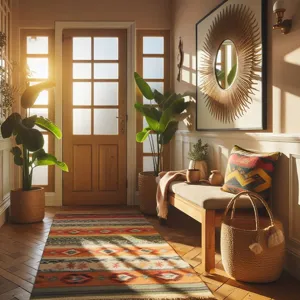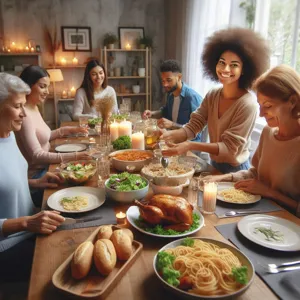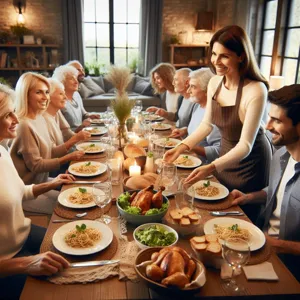The entryway of your home sets the tone for what lies beyond, serving as the first impression for guests and a warm embrace for you and your family after a long day.
A well-designed front porch not only enhances your home’s curb appeal but also creates a welcoming atmosphere that invites connection and comfort. Whether you have a sprawling porch or a cozy stoop, transforming this space into a charming and functional entryway can be both an exciting and rewarding endeavor. From choosing the right furniture and decor to incorporating greenery and lighting that highlights your style, this blog post will guide you through essential tips and creative ideas to breathe new life into your front porch. Let’s explore how you can create an inviting entryway that reflects your personality and welcomes all who cross your threshold!
1. The Importance of a Welcoming Entryway

The entryway of your home serves as both a literal and figurative threshold, setting the tone for what lies beyond. It is the first impression visitors receive and often reflects the personality and warmth of the household. A welcoming entryway invites guests in, makes them feel comfortable, and creates an atmosphere of hospitality. But its importance goes beyond aesthetics; a well-designed front porch can also enhance your home’s curb appeal and boost its overall value.
Imagine stepping onto a front porch adorned with potted plants bursting with color, a cozy seating area that beckons for conversation, and tasteful lighting that softly illuminates the space in the evening. This inviting environment not only charms your guests but also offers a serene escape for you to unwind after a long day.
Moreover, a welcoming entryway fosters community and connection. It encourages neighbors to stop by for a chat and creates a sense of belonging. When your porch is inviting, it signals to the world that your home is open and ready to welcome friends and family alike.
In today’s fast-paced world, where connections can often feel fleeting, transforming your entryway into a warm and inviting space is an opportunity to cultivate relationships and create lasting memories. It’s time to embrace the importance of a welcoming entryway and transform your front porch into a charming gateway that reflects the heart of your home.
2. Assessing Your Current Entryway Space
Before diving into any transformation project, it’s essential to take a close look at your current entryway space. This initial assessment will inform your design decisions and help you create a welcoming front porch that reflects your style while being functional. Start by stepping back and observing your entryway from a distance. What is the first impression it gives? Is the space cluttered, dark, or uninviting? Take note of any elements that may detract from its charm, such as peeling paint, overgrown plants, or outdated fixtures.
Next, consider the layout. Is your porch spacious enough to accommodate seating or decorative accents, or is it more suited for a minimalist approach? Measure the dimensions of the area, paying attention to the height, width, and depth, so you know how much room you have to work with. This will help you determine what furniture and décor can fit without overcrowding the space.
Evaluate the lighting as well. Is the porch well-lit during the evening, or does it feel dim and unwelcoming? Natural light can make a world of difference, so consider how the sun moves across the porch throughout the day. If you have the opportunity, adding larger windows or a skylight can enhance the ambiance significantly.
Lastly, think about the materials and colors currently in use. Do the existing elements complement each other, or do they clash? A cohesive color palette and harmonious materials can create a more inviting atmosphere. After this thorough assessment, you’ll be equipped with the insights needed to embark on your entryway transformation journey. Whether your goal is to create a cozy nook for morning coffee or a vibrant space for entertaining guests, understanding your starting point is the key to a successful makeover.
3. Choosing the Right Color Palette

Choosing the right color palette for your entryway is a crucial step in creating a welcoming front porch that reflects your personal style while also enhancing your home’s curb appeal. Colors have the power to evoke emotions and set the tone for the entire space, so it’s essential to select hues that harmonize with the architecture of your home and the surrounding environment.
Start by considering the mood you want to create. Soft, muted colors like pastel blues, greens, or muted yellows can impart a sense of tranquility and charm, making visitors feel instantly at ease. On the other hand, bold colors such as deep reds, vibrant blues, or eye-catching yellows can make a striking statement, showcasing your personality and inviting curiosity.
When selecting your color palette, think about the existing elements of your porch, including the front door, siding, and any outdoor furniture or decor. A cohesive color scheme can tie these elements together beautifully. For instance, if your home features a classic white exterior, a navy blue door can add a timeless touch, while bright mint green accents in your planters and cushions can inject a playful vibe.
To create depth and interest, consider using a combination of complementary colors. Perhaps a warm taupe for the walls paired with cheerful sunflower yellow accents in your decor will create a sunny, inviting atmosphere. Don’t shy away from experimenting with textures, too; a matte finish on the walls can contrast beautifully with glossy furniture or polished hardware, adding dimension to the overall look.
Finally, don’t forget to take into account the seasonal changes. Seasonal decor can provide an opportunity to refresh your palette throughout the year, incorporating autumnal oranges and deep browns in the fall, or fresh floral prints in the spring. By carefully selecting a color palette that resonates with you and complements your home, you can create a front porch that is not just an entrance, but a true extension of your living space—a warm invitation for friends, family, and neighbors alike.
4. Selecting Functional Furniture for Your Porch
When it comes to transforming your entryway, the furniture you choose for your front porch can make all the difference in creating a welcoming atmosphere. Selecting functional furniture not only enhances the aesthetic appeal of your space but also adds practicality, allowing you and your guests to enjoy the outdoors comfortably.
Start by assessing the size of your porch. A small balcony may require sleek, space-saving options like a bistro table and chairs, while a larger porch can accommodate a cozy rocking chair or a charming porch swing. Opt for materials that can withstand the elements—weather-resistant wicker, durable metal, or treated wood are excellent choices that ensure longevity and ease of maintenance. If your porch receives ample sunlight, consider furniture with UV-resistant finishes to prevent fading over time.
In addition to aesthetics, think about functionality. Adding a small side table can provide a convenient spot for drinks, books, or decorative elements, while storage benches serve a dual purpose, offering seating and space to tuck away outdoor cushions, gardening tools, or seasonal decor. Look for items that invite relaxation, like plush cushions or soft throws, which can transform your porch into a cozy retreat.
Moreover, consider the flow of movement on your porch. Arrange your furniture to create an open, inviting space that encourages conversation and allows easy access. Incorporate elements like a small ottoman for extra seating or a hammock chair that can sway gently in the breeze, inviting guests to sit and stay awhile.
Ultimately, selecting functional furniture for your front porch should reflect your personal style while serving the practical needs of your household. With the right pieces in place, your entryway will not only be an inviting first impression but also a cherished area where memories are made with family and friends.
5. Incorporating Greenery and Plants

Incorporating greenery and plants into your front porch can dramatically enhance the welcoming atmosphere of your entryway. Imagine stepping onto a porch adorned with lush ferns swaying gently in the breeze, or vibrant petunias spilling over colorful pots, instantly rejuvenating your space. Plants not only add visual interest but also bring a sense of life and vitality that can make your home feel more inviting.
Begin by selecting plants that thrive in your local climate and the specific lighting conditions of your porch. For sunny spots, consider a mix of cheerful annuals like marigolds or geraniums, which bloom brilliantly throughout the season. In shadier areas, hostas and ferns can provide lush greenery and texture. Adding a few potted herbs, such as basil or rosemary, can infuse your entryway with delightful scents, enhancing the sensory experience for anyone who approaches your home.
Vertical gardening is another fantastic option for smaller porches. Utilize wall-mounted planters or hanging baskets to create a striking visual display without sacrificing floor space. This not only maximizes your planting area but also draws the eye upward, making your entryway feel more expansive and inviting.
Don’t forget about seasonal decorations! Swap out your plants or add seasonal accents, like pumpkins in the fall or festive poinsettias during the winter holidays, to keep your porch feeling fresh and relevant throughout the year. With just a bit of creativity and care, incorporating greenery and plants into your front porch will create a warm, inviting space that leaves a lasting impression on every visitor.
6. Adding Personal Touches with Decor
When it comes to transforming your entryway, adding personal touches with decor is where you can truly let your creativity shine. Your front porch is the first glimpse guests get of your home, and it should reflect your unique style and personality. Consider incorporating decorative elements that tell your story, making your entryway not just welcoming but also a reflection of who you are.
Start by selecting a theme that resonates with you—be it rustic charm, coastal vibes, or modern minimalism. This theme can guide your choices in furnishings and accessories. For example, a set of vintage chairs paired with a weathered wooden table can evoke a cozy, farmhouse feel, while sleek metal accents and geometric planters might lend a contemporary touch.
Next, think about incorporating personal mementos that have meaning to you. This could be a collection of handcrafted pots filled with your favorite flowers or a whimsical welcome sign that you picked up during your travels. These thoughtful additions not only enhance the visual appeal of your porch but also spark conversations and create a sense of warmth.
Lighting also plays a crucial role in setting the mood. Consider string lights draped above or lanterns that cast a soft glow to create an inviting atmosphere, especially during evening gatherings. Don’t forget to include seasonal decorations that can be easily swapped out throughout the year—think pumpkins in the fall, fresh greenery for winter, or vibrant florals for spring and summer. These changing accents keep your porch feeling fresh and lively.
Finally, add comfort with soft textiles. Outdoor cushions, a cozy throw blanket, or a patterned rug can make your entryway feel more inviting and encourage guests to linger a little longer. By thoughtfully curating your decor, you can create a front porch that not only welcomes guests but also serves as a beautiful extension of your home, showcasing your personality and style.
7. Lighting Ideas to Enhance Ambiance

The right lighting can dramatically transform your entryway, creating an inviting atmosphere that beckons guests to step inside. When considering lighting options for your front porch, think beyond conventional fixtures; it’s about crafting a mood that reflects your personal style while ensuring functionality.
Start with layered lighting for depth and interest. A combination of ambient, task, and accent lighting can illuminate your space beautifully. Consider installing a stylish overhead fixture, like a pendant or chandelier, as the central source of light. Choose designs that complement your porch’s aesthetic—whether that’s vintage charm, modern sleekness, or rustic warmth.
Next, add wall sconces on either side of your front door to create a welcoming glow. These fixtures not only enhance safety by illuminating the entryway but also frame your door, drawing attention to it. For a touch of whimsy, you might opt for lantern-style sconces that evoke a cozy, homey feel.
Don’t forget about the ground! Pathway lights can guide guests to your door while accentuating your landscaping. Low-voltage options or solar-powered lights offer eco-friendly solutions that are easy to install and maintain. Strategically placing these along walkways or flower beds can create a magical ambiance in the evening.
For a more intimate touch, consider adding string lights or fairy lights. These can be draped across the porch ceiling, around railings, or even in nearby trees to create a twinkling canopy that invites relaxation. A small tabletop lantern or candle arrangement can also add warmth and charm, perfect for cozy evenings with friends or quiet nights spent on the porch.
Finally, think about the color temperature of your bulbs. Warmer tones (around 2700K) create a soft, inviting glow, while cooler tones can feel harsher and more clinical. Choosing the right lighting not only enhances the ambiance but also highlights the beauty of your entryway, making it a delightful introduction to your home. With these lighting ideas, your front porch can become a welcoming haven, ready to greet friends, family, and new visitors alike.
8. Creating a Seasonal Display
Creating a seasonal display is one of the most delightful ways to transform your entryway and make your front porch feel inviting throughout the year. Each season brings a unique palette of colors, textures, and themes that can be beautifully showcased, allowing your home to reflect the changing landscape outside.
**Spring** invites a burst of life with vibrant blooms and fresh greenery. Consider adorning your porch with pots of colorful seasonal flowers like tulips, daffodils, and pansies. A charming bird feeder or a whimsical garden statue can add a touch of personality. Incorporating pastels into your décor, such as light-colored cushions or decorative pillows on outdoor seating, further enhances the cheerful ambiance of the season.
As **summer** rolls in, embrace the warmth with a display that exudes relaxation and leisure. Think about setting up a cozy seating area draped in bright, summery fabrics. Hanging string lights or lanterns can create a magical glow in the evenings. Incorporate elements that celebrate summer, like a rustic wooden crate filled with fresh herbs or a stylish basket brimming with locally sourced fruits.
**Autumn** brings a rich tapestry of warm hues and textures. Use pumpkins and gourds in various shapes and sizes to create a stunning arrangement. Mums, with their vibrant colors, are perfect for adding seasonal flair. Swap out your cushions for deeper, richer tones and add a cozy throw blanket to invite guests to sit and enjoy the crisp air. Don’t forget to include a rustic wreath made of dried leaves and twigs to greet visitors at the door.
When winter descends, transform your entryway into a cozy haven. Deck the porch with evergreen garlands and twinkling lights that evoke a sense of warmth and cheer. Pinecones, holly, and winter berries can be incorporated into your display for a festive touch. A classic door wreath adorned with a big red bow can serve as a striking focal point. If you live in a snowy area, consider placing a pair of decorative sleds or snowmen as cheerful accents.
By embracing the seasons and celebrating their unique beauty, you create a front porch that not only welcomes guests but also showcases your creativity and personal style. Each seasonal display can become a reflection of your home and your appreciation for the world outside, making your entryway a delightful sight for all who pass by.
9. The Role of Textiles: Rugs and Cushions
When it comes to transforming your entryway, one of the most effective ways to create a warm and inviting atmosphere is through the strategic use of textiles—specifically rugs and cushions. These elements not only add comfort but also introduce layers of color, texture, and personality to your front porch, making it a true extension of your home.
Imagine stepping onto a soft, decorative rug that welcomes you with its vibrant patterns and plush fibers. A well-chosen rug can define your space, offering a visual anchor that draws the eye and encourages guests to linger. Opt for outdoor rugs made from durable materials that can withstand the elements yet still provide a cozy feel underfoot. From bold geometric designs to subtle, muted tones, the right rug can set the mood for your porch, whether you envision a bohemian retreat or a classic, elegant entryway.
Cushions are another essential textile element that can elevate your front porch design. Strategically placed on rocking chairs, benches, or even old-fashioned porch swings, they invite relaxation and conversation. Choose weather-resistant fabrics that can endure sun and rain while maintaining their vibrant colors. Mixing and matching patterns and textures can create a dynamic look that adds visual interest. Consider using cushions in complementary colors to your rug to create a cohesive aesthetic or contrasting hues for a more eclectic vibe.
Incorporating textiles like rugs and cushions not only enhances comfort but also reflects your personal style. They serve as functional décor that can easily be updated with the seasons—a vibrant floral print for spring, rich earthy tones for fall, or even festive patterns for the holidays. By thoughtfully selecting and arranging these textile elements, your front porch will not only welcome guests with open arms but also provide a charming and inviting space for you to enjoy.
10. Maintaining a Clutter-Free Entryway
Maintaining a clutter-free entryway is essential to creating a welcoming front porch that invites guests in and sets a positive tone for your home. The entryway often serves as the first impression for visitors, so keeping it tidy is key to showcasing your personal style and hospitality.
Start by assessing the items that typically accumulate in this space. Shoes, bags, and outdoor gear can quickly turn a charming porch into a chaotic mess. Consider implementing designated storage solutions, such as stylish baskets, shoe racks, or decorative hooks, to keep these essentials organized and out of sight. Choose items that complement your porch’s aesthetic—think natural materials like wicker or rustic wood that enhance the overall ambiance.
Next, be mindful of seasonal decor. While it’s lovely to showcase festive touches throughout the year, too many decorations can lead to visual clutter. Opt for a few carefully chosen pieces that reflect the season without overwhelming the space. A simple, seasonal wreath on the door, a couple of potted plants, or a well-placed lantern can add charm without creating chaos.
Regularly reassess your entryway, taking a few moments each week to declutter. Encourage family members to do the same by establishing a routine where everyone checks their belongings before entering the house, ensuring that unnecessary items don’t pile up.
By fostering a clutter-free environment, your entryway will not only remain inviting but also reflect the warmth and care you put into your home, making every visitor feel welcome from the moment they step onto your porch.
11. DIY Projects for a Unique Touch
When it comes to transforming your entryway, embracing diy projects is a fantastic way to add a unique touch that reflects your personal style. A well-crafted DIY piece not only enhances the aesthetic appeal of your front porch but also showcases your creativity and craftsmanship. Here are some engaging ideas to inspire your next project.
**1. Customized Welcome Sign**: Begin with a simple wooden board or a pre-cut sign and let your imagination run wild. Paint it with inviting colors, add your family name, or a cheerful message like “Welcome Home!” Use stencils or freehand for a personal touch. This sign can serve as a focal point, greeting visitors with warmth right from the start.
**2. Handcrafted Planters**: Wooden crates, terracotta pots, or even repurposed items like old tires can be transformed into charming planters. Fill them with vibrant flowers or lush greenery that not only add color but also create a refreshing atmosphere. Consider painting or staining the planters in colors that complement your home’s exterior.
**3. Upcycled Furniture**: Give new life to old furniture by upcycling it for your porch. A weathered bench can be painted and cushioned for a cozy seating area, while an old ladder can serve as a stylish plant stand. These projects are not only environmentally friendly but also provide functional and aesthetic benefits.
**4. Unique Lighting Solutions**: Create your own outdoor lighting fixtures to make your porch sparkle in the evenings. Use mason jars as hanging lanterns, fill them with fairy lights, and suspend them from your porch ceiling or trees. Alternatively, repurpose an old chandelier by adding weather-resistant bulbs for a touch of elegance.
**5. Seasonal Decor Swaps**: Consider a DIY seasonal decor strategy where you can easily swap decorations based on the time of year. Create interchangeable wreaths for your front door or festive banners that highlight holidays and seasons, ensuring your entryway always looks fresh and inviting.
These projects can be as simple or intricate as you desire, allowing you to infuse your personality into your home’s first impression. Plus, the satisfaction of creating something with your own hands adds an extra layer of warmth to your entryway, making it a truly welcoming space for family and friends alike. So gather your tools, unleash your creativity, and transform your front porch into a unique reflection of you!
12. Safety and Accessibility Considerations
Creating a welcoming front porch goes beyond aesthetics; it’s essential to prioritize safety and accessibility to ensure that all visitors feel comfortable and secure from the moment they arrive. This begins with a thorough assessment of your entryway. Check for any potential hazards, such as uneven steps, loose railings, or slippery surfaces. Repairing these issues not only enhances the safety of your porch but also prevents accidents that could discourage guests from visiting.
When it comes to accessibility, consider the needs of all potential visitors, including those with mobility challenges. Installing a sturdy handrail along steps can provide necessary support, while a gently sloping ramp can offer easy access for wheelchairs or strollers. Make sure the pathway leading to your porch is clear and well-lit, especially if you expect guests during the evening.
Incorporate non-slip mats or textured surfaces to reduce the risk of slipping, particularly in wet or icy conditions. Additionally, if your porch features any outdoor furniture, choose pieces that are easy to get in and out of, ensuring everyone can comfortably enjoy the space.
Finally, consider adding lighting elements, such as solar-powered lanterns or motion-sensor lights, to illuminate your entryway. Not only do they enhance safety during nighttime visits, but they also create a warm and inviting ambiance that beckons guests to your home. By thoughtfully addressing safety and accessibility, you not only enhance your front porch’s appeal but also demonstrate your commitment to making everyone feel welcome.
13. Inviting Features: Seating and Conversation Areas
Creating inviting features on your front porch, such as seating and conversation areas, can transform an ordinary entryway into a warm and welcoming space that beckons guests to linger. Imagine stepping onto your porch and being greeted by a cozy seating arrangement that perfectly balances comfort and style. Whether it’s a pair of rocking chairs swaying gently in the breeze or a plush bench adorned with colorful cushions, these elements invite visitors to sit down, relax, and enjoy the atmosphere.
Consider incorporating a small coffee table or side tables to hold refreshments, magazines, or decorative items, fostering an inviting environment for casual conversations. A well-placed swing can add a touch of whimsy, encouraging friends and family to gather and unwind as they share stories and laughter.
To further enhance the ambiance, think about the placement of lush potted plants or hanging planters filled with vibrant blooms. These natural elements not only add color but also create a sense of tranquility and connection to nature.
Lighting plays a crucial role in making your porch a welcoming space, too. String lights or lanterns can provide a soft glow that invites evening relaxation, while sconces or fairy lights can add a touch of charm and warmth.
By thoughtfully designing your seating and conversation areas, you create an entryway that not only welcomes visitors but also encourages them to stay awhile, enjoy the scenery, and feel right at home. A well-appointed front porch is more than just an entrance; it’s an invitation to connect, unwind, and savor the simple joys of life.
14. Engaging the Senses: Scents and Sounds
Engaging the senses is a powerful way to create an inviting atmosphere on your front porch. The right scents and sounds can transport your guests into a world of comfort and warmth before they even step inside your home.
**Scents** play a pivotal role in setting the mood. Consider incorporating fragrant plants and flowers such as lavender, rosemary, or jasmine, which release delightful aromas that can be both soothing and invigorating. A strategically placed pot of fresh herbs not only beautifies your space but also invites the scent of nature right to your doorstep. For an extra touch, consider using scented candles or essential oil diffusers. Choose warm, inviting scents like vanilla, cinnamon, or citrus to create a cozy ambiance that makes guests feel at home.
**Sounds** are equally important in crafting a welcoming entryway. The gentle tinkling of wind chimes or the soft rustle of leaves can create a peaceful oasis that draws people in. If your porch is large enough, adding a small water feature, such as a fountain, can introduce the calming sound of trickling water, further enhancing the serene environment. You could also curate a playlist of soft music that can be played in the background during gatherings, adding a personal touch that resonates with visitors.
By thoughtfully integrating these sensory elements, your front porch will transform into a welcoming retreat that beckons friends and family to relax, unwind, and enjoy their time in your space. The result? A memorable entryway that leaves a lasting impression, encouraging guests to linger a little longer.
15. Final Thoughts: Celebrating Your Transformed Entryway
As you step back to admire your newly transformed entryway, take a moment to revel in the inviting atmosphere you’ve created. Your front porch is no longer just a transition space; it has become a warm and welcoming introduction to your home. The vibrant colors of fresh paint, the charm of carefully selected furniture, and the delightful accents of greenery and decor all work together to evoke a sense of comfort and style.
Consider hosting a small gathering with family and friends to celebrate your efforts. Share your design journey and the inspiration behind your choices, inviting others to appreciate the space as much as you do. Perhaps set up a cozy seating area with soft cushions and warm blankets, perfect for sipping tea or enjoying a good book as the sun sets.
Don’t forget to maintain the beauty of your entryway. Regularly tending to plants, refreshing decor, and ensuring the space remains tidy will keep that inviting vibe alive throughout the seasons. As the years go by, continue to adapt and evolve your front porch, incorporating new trends or personal touches that reflect your ever-changing tastes.
Ultimately, your transformed entryway is more than just a pretty space; it serves as a reflection of your personality and hospitality. It’s a place where memories will be made, where conversations will flow, and where guests will feel a genuine sense of welcome. Celebrate this transformation, and let it be a reminder of the joy that comes from creating a beautiful home.
In conclusion, transforming your entryway into a welcoming front porch is an opportunity to make a lasting first impression and create a warm atmosphere for both your guests and yourself. By incorporating elements such as inviting decor, comfortable seating, and thoughtful lighting, you can turn an ordinary entrance into an extraordinary space that reflects your personal style. Remember, the key is to balance aesthetics with functionality, ensuring that your porch is not only beautiful but also practical for everyday use. We hope these tips inspire you to reimagine your entryway and create a charming welcome that sets the tone for your home. So gather your favorite plants, cushions, and decor, and embark on this delightful journey of transformation—your front porch is just waiting to shine!








